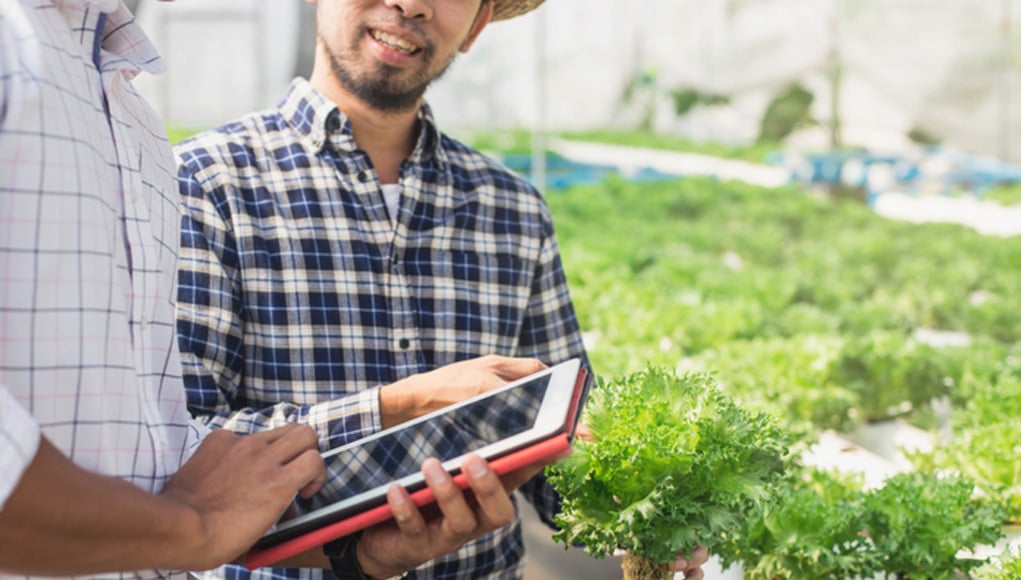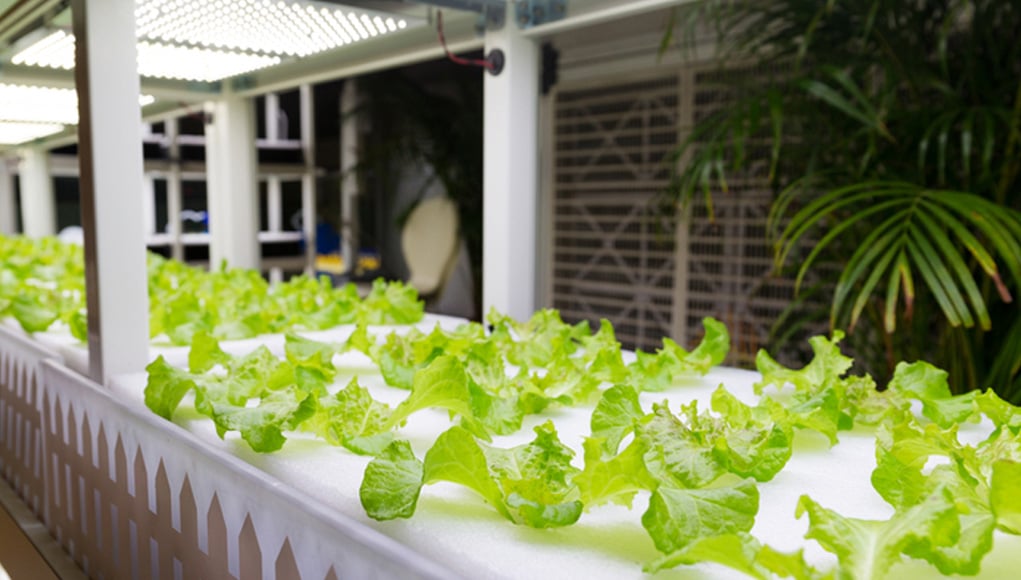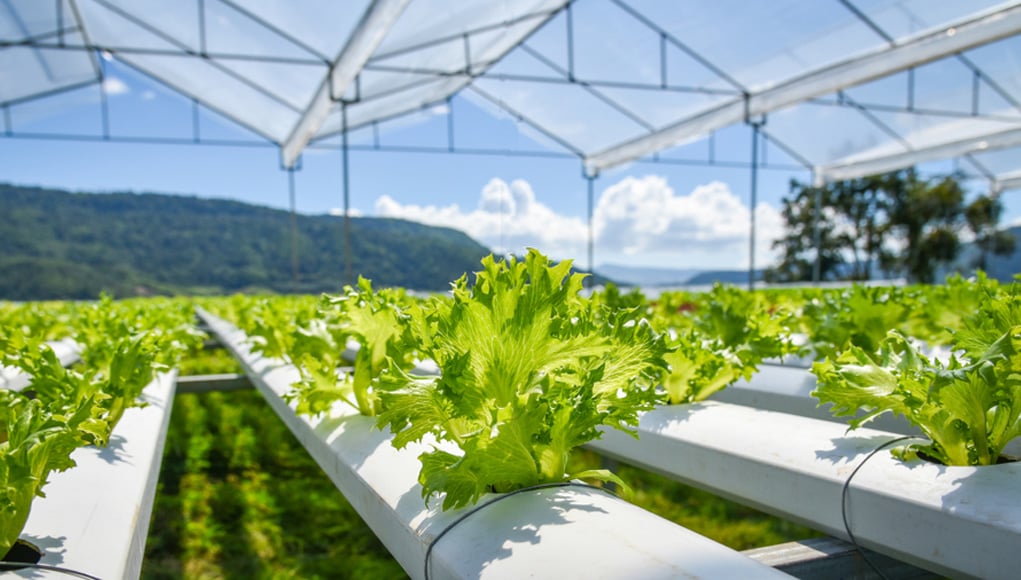Ready to start your own hydroponic system? Then what do you need for hydroponics and the basic components you should look for?
There’s a lot of room for creativity when making a DIY hydroponic system. And our previous guide provided a step-by-step tutorial on how to create a hydroponic system and the materials and equipment needed.
But to further deepen your knowledge about hydroponic farming, we will unveil the following in this article:
- A detailed list of hydroponics supplies and why are they necessary
- Pro tips on how to utilize these materials the right way
- The answers of common questions about what is needed for hydroponic gardening
So, get your checklist ready, and let’s begin!

What Do You Need for Hydroponics – Basic Components to Look For
We categorized the materials into three including growing systems, planting, and maintenance to give you insights on why, when, and how to use them. So, let’s get right into the basics of hydroponics.
What Do You Need for Hydroponics’ Growing System
Here are the things you need to set up or build your hydroponic system.
1.Water
One of the most crucial components of a hydroponic system is water. It may seem the easiest to source but hold up! You can’t use just any water.
Even tap water is not safe. You can only use it if you treat it properly beforehand. Why?
你的水龙头流出来的水可能一去不复返了through chlorination and chloramination. Aside from that, you also need to consider water PPM.
Things to consider when choosing water for hydroponics:
Chlorination
It refers to adding chlorine or hypochlorite to kill bacteria and other microbes in your drinking water.
And guess what? Chlorine is highly toxic to such tiny organisms, which can kill the beneficial bacteria in your nutrient reservoir. So, it’d not be ideal for hydroponic plants.
Solution:
Here’s the good news for you! The chlorine will break down if you’d leave your tap water out in the sun for about 24 hours.
To make it clear, the chlorine will not evaporate. Instead, chlorine will naturally break down when exposed to UV rays.
Chloramination
Simply put, this water disinfectant is a combination of chlorine and ammonia, and it lasts longer than regular chlorine. Therefore, it’s harder to break down.
On top of that, it’s toxic to fish, so if you’re using the aquaponic system, that can be detrimental to them.
But do not fret. Here are three remedies that can make your water chloramine-free.
Solution:
1.A carbon filter like the Brita filter
2. Sterilants like Campden tablets
3. Sodium thiosulfate
If you don’t want to use those options, you can opt to boil your tap water, but it can be time-consuming.
Water PPM
Have you ever noticed a nasty buildup on your showerhead before? That is caused by hard water.
Hard water contains lots of minerals like calcium and magnesium. Still, an overabundance is not suitable for your plants either because plants don’t need them as much as they need macronutrients.
So, the rule of thumb is to keep the water in the range of 200 to 300ppm (parts per million).
How can you do that?
You can useBluelab PPM meterto measure your water’s PPM. It’s dual-purpose because it helps test the nutrient solution’s PPM.
If your tap water has high PPM, you may run it through a filter or reverse Osmosis to dilute its concentration.
So what’s the best kind of water to use in hydroponics?
Best water options for hydroponic farming systems:
1.Distilled
It’s the safest choice since it contains no harmful contaminants, but it’s costly. Good thing you can add it to some treated tap water to create a healthy pH level and cut some costs.
2. Reverse Osmosis
It refers to the process of purifying water through a semi-permeable or partially permeable membrane to remove unwanted contaminants and molecules.
This solution is effective, yet it’s costly and wastes water to produce.
3. Filtered water
The filtration process gets rid of the harmful contaminants, so this option is also excellent for plants.
You can also use well water and rainwater if they’re treated.
After choosing the water to use, the next thing is a reservoir where you’ll put the water to.
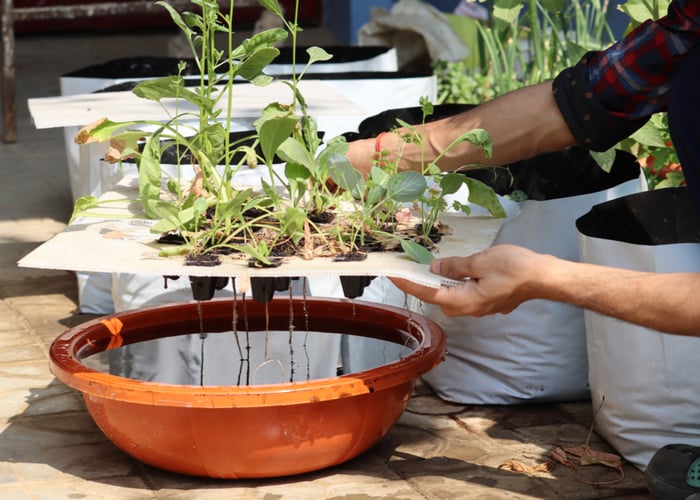
2. Water Reservoir
A reservoir is essential in storing and delivering nutrients to the plants. You have to use it in preparing the nutrient solution too.
Some hydroponic gardeners have been creative with their reservoirs. Others use empty household storage bins, while others use empty buckets.
But when choosing a reservoir for your hydroponic garden, it’d help to consider the size, lid, and color.
Size
The size of the reservoir you need depends on your crop’s size.
Here’s a simple guideline you can follow. It’s just the minimum volume required, and you can opt for a reservoir that is twice the size in the guideline.
Small plants – half a gallon of water or 1.9 liters of nutrient solution per plant
Medium-sized plants – at least 1 ½ gallons or 5.7 liters of nutrient solution per plant
Large plants – 2 ½ gallons or 9.5 liters of nutrient solution per plant
Lid
Every reservoir needs a lid that snuggly fits into it to prevent nutrient evaporation and avoid nutrient wastage.
It also limits algae growth and other foreign materials from entering the reservoir.
The lid also supports the plants. If you do not have a lid, you may also use extruded polystyrene or insulation sheets.
Just let it sit over the top and float on top f the water and support it with a PVC tube to enable it to support extra weight when the plant grows bigger.
Color
Water reservoir comes in many colors. But black and opaque are best to keep the nutrient solution dark and prevent the growth of algae.
It reduces the frequency of the need to clean the reservoir and improves your plant’s health.
Reservoir’s location
It’s best to place the reservoir close to a water source and out of the direct sunlight to avoid rapid temperature and pH changes which can cause adverse effects on plant health.

3. Light
Just like soil-grown plants, hydroponically grown crops also need light and heat to grow and make food. You have various light sources to choose from.
Natural light
The sun is the cheapest light source that provides a fully visible and non-visible light spectrum. Six hours of exposure to direct light per day is enough for many vegetable plants.
Even greenhouses and southern-facing windows can provide this amount. But if you want to grow your crops indoors, you need a different light source.
LED lights
This supplemental lighting is essential, especially during winter when there’s not enough sunlight.
There are four types of grow lights available, and each has its pros and cons.
1.LED (Light Emitting Diode)
LED lights are energy-efficient, durable, and long-lasting, and they come in various colors, styles, and sizes. They also provide a wide spectrum of light without giving off too much heat.
However, it requires a higher up-front cost than other light bulbs.
2. Fluorescent lights
These lights are moderately efficient. Some of them have a broad spectrum that includes red light, but others only have a blue-green spectrum, so you need to check them before purchasing.
The downsides of fluorescent lights are they consume more energy, but they’re not as long-lasting as LED.
3. Incandescent lights
Incandescent lights are the cheapest to buy, but it’s not as energy-efficient as the previous options and not durable.
4. High-pressure sodium
This light is an old technology but still provides substantial light. However, it emits much heat and is better for large-scale systems, although some of its light is not usable to plants.

4. Tubes or PVC Pipe
A fill tube and a drain tube are necessary to use an ebb and flow system and nutrient film technique.
This tube’s purpose is to connect the reservoir to the tray. The fill tube will be attached to a submersible pump with a timer that controls the water flow.
On the other hand, the drain tube’s job is to pull the water back to the reservoir after flooding to be recycled and reused.
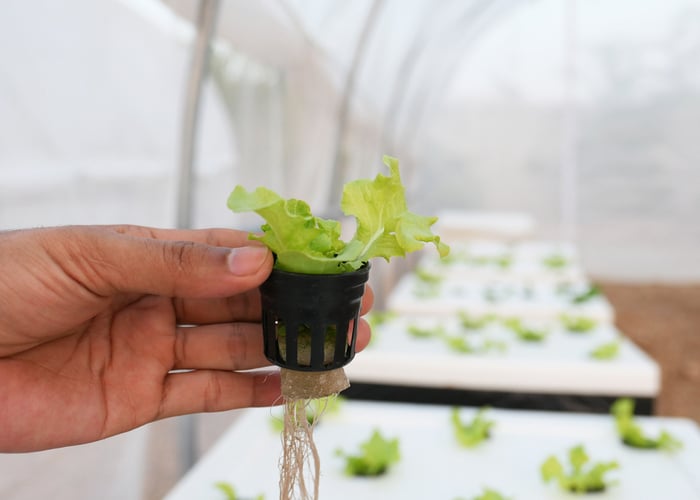
What Do You Need for Hydroponics Planting
Now let’s move on to the essential material for planting. Without the following, growing crops wouldn’t be possible.
5. Grow Trays and Net Pots
Plants need a support structure, and the most commonly used in hydroponics are net pots and substrate.
The net pot is a tiny pot with holes or slits that allow the roots to reach the nutrient solution. It comes in various sizes and is partially submerged in the water to give way for oxygenation.
And the substrates are used to fill the net pots as a substitute for the soil. There’s a wide range of substrates you can choose from, but the popular ones are the following.
- Rockwool
- Perlite
- Hydroton/LECA
- Pumice
- Gravel
- Coconut Coir
6. Seeds
Seeds should be planted separately and then transplanted into the hydroponic system once they have germinated.
Here are two ways to plant seeds:
Seeds are planted in starter cubes.
Plant starter cubes or grow plugs can be found online or at some gardening stores.
When your seeds have germinated, the cubes are made of rock wool or coconut coir and may be placed directly into the bigger system.
Before using, soak the starter cubes in water and leave them partially submerged (but not entirely).
The roots are ready for a transplant once they have pushed through the bottom of the cube.
Before you start, read the directions on the packaging carefully because different initial cubes are composed of other materials.
Starting seeds in the soil
You can also plant seeds in potting soil, just as you would if you were growing them in your garden.
When using this method, clean the roots to eliminate any remaining soil before transplanting them.
You’ll need a warm, humid environment, just like planting seeds for a garden. In a south-facing window, start seeds in a container with a lid (such as a plastic storage container).
Try getting a heating pad or growing your seedlings under grow lights if you don’t have a south-facing window.
7. Nutrients or Fertilizers
Plants require 17 nutrients to grow and develop appropriately.
In a hydroponic system, plants have access to only carbon, hydrogen, and oxygen.
Plants need a lot of nitrogen, phosphorous, and potassium. Hence they’re considered macronutrients. If you’ve ever gardened outside, you’re probably familiar with using commercial fertilizer or compost to provide these nutrients to your plants.
Other nutrients are rarely a concern in traditional soil-based farming methods because many of these necessary elements are already present in the soil. However, not only nitrogen, phosphorus, and potassium are required in hydroponics, but also:
- calcium
- magnesium
- sulfur
- manganese
- iron
- molybdenum
- copper
- zinc
- boron
- chlorine
- nickel
Types of Fertilizers:
Liquid Fertilizer
Liquid fertilizers are typically simple; simply measure the recommended amount (the label will indicate how much to put per gallon of water) and pour it into the water. On the other hand, liquid fertilizers are expensive due to their weight and shipping expenses.
Dry Fertilizer
Dry fertilizers are much less expensive. However, they are occasionally sold as a multi-part mix. If you order dry fertilizer for lettuce, you may receive three or more different bags that you must combine on-site.
Since the different nutrients have varied weights and solubilities, they keep better and are less likely to separate if mixed right before use. Other dry fertilizers can be purchased pre-mixed.
So we recommend purchasing a hydroponic fertilizer tailored to your crop’s needs.
How to Make a Nutrient Solution for Hydroponics
1.买泻盐和微量元素混合/ water-soluble fertilizer.
2. Check the instructions before mixing.
3. Add the right amount of fertilizer (usually two teaspoons) into the water and stir it thoroughly.
4. Add a teaspoon of Epsom salts for every gallon of water, and you’re done!

What Do You Need For Hydroponics Maintenance
Some of these devices are necessary during the preparation of water and atmosphere for the plants but they’re also necessary during maintenance checkups.
8. Temperature Control
Temperature is easy to control in indoor hydroponics, and making a microclimate is highly beneficial, especially during winter when the temperature drops outside.
The ideal atmosphere temperature for plants is 70°F. This temperature should stay throughout the day and night.
Aside from the atmosphere, you need to check the water basin’s temperature. It’s best to keep the water at room temperature, preferably between 65°F and 80°F.
9. Air Stone and Pump
Your hydroponics need an aeration system consisting of air stone and a pump to provide oxygen to the crop’s roots.
This way, your plants wouldn’t get drowned. It’s crucial for wick set-up and other systems where roots don’t have the chance to dry out completely.
The air stone and pump work similar to aquariums, where the pump will push the air through the stone and produce tiny bubbles that distribute oxygen in the water.
It’s ideal for multiple plants with different root lengths planted in the same container.
Your hydroponics also needs a water pump to pump water and deliver nutrients.
Types of Water Pumps Used in Hydroponics:
Submersible water pumps
These pumps are submerged in the water, are cooled by it, and depend on hoses and fittings to transport water and nutrients throughout the system.
Inline water pumps
This pump is mounted on the system’s exterior, is air-cooled, and distributes water and nutrients from the reservoir to the tray and growing medium.
10. Water Pump Timer
Not all hydroponic systems need a timer but aeroponics, drip, and ebb and flow heavily rely on it for water and nutrient movement.
It allows you to control the length and frequency of watering based on your crop’s needs.
11. A pH Meter
Your water’s pH level is vital to a plant’s health, so you have to get it right. Vegetables’ ideal pH level is 5.5 to 6.0, while berries need a lower level of around 4.0 to 5.0.
But how will you know the hydroponic water’s pH level?
Here are three pH tester types that help measure the acidity and alkalinity of water:
Pen Testers
Pen testers are small pH meters that are usually the least expensive. The compact design includes a pH meter, LCD, and electrode, making them highly convenient to travel and use on the go.
Handheld Meters
Handheld meters are often more durable than pen testers, with a slightly bigger design. The electrode is separate from the meter in this design.
Handheld meters usually include interchangeable electrodes for different pH measurements. For medium-to-firm items, for example, spear-tipped electrodes are employed.
手持米使用的设计事业d. Environmental officers, field research, aquaculture, agriculture, and water treatment.
Benchtop pH Meters
They are the largest among the three, either on a desk or wall-mounted. They have the highest degree of accuracy, that’s why they’re suitable for laboratory use.
You can find them usually in food processing or water testing facilities and quality assurance labs.
If you want a cheaper option, pH test strips are for you. You can just dip it into the water for a few seconds and pull it back. In just 10 seconds, you’ll already see the result.
What will you do if the pH level falls too low or higher than the recommended level?
How to adjust pH:
If the water’s pH level is too high, you can lower it by adding an alkaline baking powder.
But if the pH level falls short, you have to add something that contains acid-like citruses, white vinegar, or lemon juice to increase the level.
Should You Buy or Build Hydroponics?
You can build your own hydroponics with little DIY skills, but it can be challenging if you’re a first-time. However, we curated a guide for you to help you with that.
It is easier, though, to set up ready-made hydroponics. But you need to consider various factors such as the following.
Factors to Consider Before Buying Hydroponics
1.The plant you want to grow
The best plants to grow in hydroponics are lettuce, microgreens, and other leafy greens and herbs such as basil, spinach, and bell peppers.
The plants you choose must complement the hydroponic system you’ll use. For example, the NFT system is not suitable for tomato plants.
So, know what system works best for your plants before purchasing.
2. Your budget
The hydroponic system’s cost may vary, but you don’t have to break the bank if you’re just learning hydroponics or a small area in your garden. There are cheap hydroponic systems under $150, and you can also upscale it to systems that cost over $400.
3. Space for your garden
How much space do you need for hydroponics?
According to the United Nations Food and Agriculture Organization, hydroponics systems can be as small as one square meter.
However, most homeowners’ basic hydroponic gardens are 10 to 20 square meters in size.
Hydroponic gardens of 200 square meters are large enough and profitable enough to sell a surplus product.
There’s a wide range of hydroponic systems, so it shouldn’t be hard to find one that meets your space requirements.
But consider water changes and maintenance too to have enough space while doing all these.
4. Garden time you have
Some systems are complicated and need more maintenance than others. So we recommend sticking to the basic types if you’re a beginner and upscale when you’re familiar and experienced with running hydroponic systems.
How Often Do I Add Nutrients to my Hydroponics?
Nutrient strength will diminish as your crops absorb it. In fact, hydroponic nutrients usually last 7 to 10 days if you drain, clean, and remix nutrients and add plain water daily. Feeding your crops once a week to keep them in optimum health should be fine.
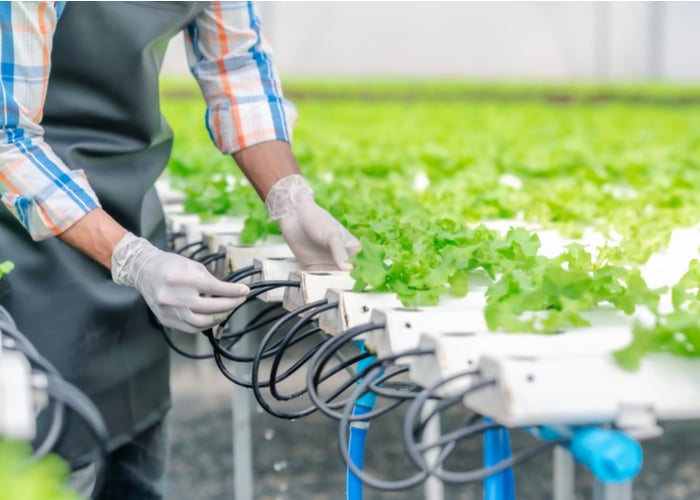
Common Questions About Hydroponics
What do you need for a hydroponics system?
In doing hydroponic farming, you should have water, light, and fertilizer or nutrients that the plants need.
It would be best to prepare the water basin, temperature control, grow trays and tables, growing medium, and specific equipment for the hydroponic systems.
What is the best hydroponic system for beginners?
The best hydroponic system for commercials is the drip and deep water system (DWS) because commercial applicators mainly use it.
However, the Aero Garden Harvest is the best choice for beginners because it’s simple to apply by adding water and nutrients.
The LED indicator will determine if the nutrient solution and water are enough.
Is hydroponics good for beginners?
Because hydroponics is as easy as soil gardening, it fits well even for beginners as long as you can provide all the water, nutrients, and oxygen needed for plants to grow without soil.
You can quickly start creating hydroponic for veggies, herbs, and fruits at your farm and home.
How do I start a small hydroponic garden?
To start a small hydroponic garden, first, you should choose what seed you will plant. Second, decide what hydroponic system you will use.
Then, choose a light source and grow the medium. After that, it’s time to purchase and prepare the nutrient solutions and supplements and a pH meter and Up/Down.
Then, you can now start your garden.
Do you need special seeds for hydroponics?
In hydroponic farming, you don’t need special seeds to plant. You can use any source to generate roots as long as you have good starter cubes such as Rockwool.
However, you should avoid using seed that typically grows in the soil, such as crawling vines, corn, melons, and tubers like potatoes.
Does hydroponics need sunlight?
Plants always require light to do photosynthesis, but it doesn’t need to be from the sun. Why? Because only the heat is necessary, not the light itself.
Because hydroponics can be outdoor orindoor gardening, you can have an artificial light indoors, releasing heat for your plants to grow.
How often do you need to change hydroponic water?
Hydroponic plants require regular water changes but too often will shock your plants and even endanger them.
So, some growers use to change the water after you fully top it off in enough time. At the same time, others change it every two to three times when the plants fully enrich the nutrients.
Does hydroponics use a lot of electricity?
Machines used in hydroponic farming like air and water pumps consume electricity. However, it is lesser than the electricity consumed by the lights.
But still, the consumptions always depend on how big your farm is and how many machines and lights you used to build it.
What lights should I use for hydroponics?
For those new growers of the hydroponic garden, it would be best to use cool white or full-spectrum fluorescent light.
It is perfect for large plants and vast plantations with a wide range of light and higher-powered metal halide bulbs to help plants grow more.
Can I use tap water for hydroponics?
Yes, you can use tap water if it is clean and treated beforehand. For example, if it is chlorinated by a filter or Campden tablets and left in the sun for 24 hours.
Then, it should have high PPM by running it through a filter or diluted concentration by mixing it with distilled or reverse osmosis water.
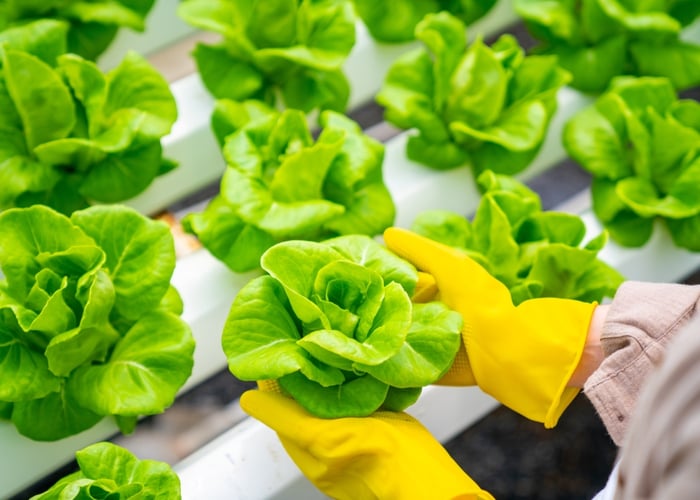
Summary – What Do You Need for Hydroponics
So, that’s it! Those are eleven things you need when making a homemade hydroponics setup.
It may sound a lot but the water, reservoir, seeds, and fertilizers are unnegotiable when you
make your own hydroponic system at home. You also need to have high-tech gadgets such as temperature control, an air stone pump, a water pump timer, and a pH meter.
当然,当生长作物肥料是必须的ps in hydroponics to deliver nutrients to the soil and keep them healthy.
